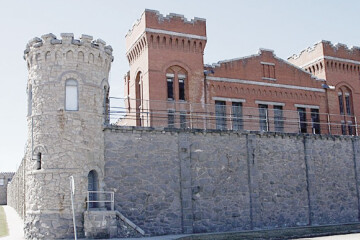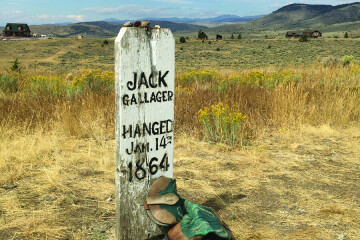Top 10 Montana Ghost Towns
Looking for a certified scare or paranormal encounter to spice up your spooky season this October? Exploring some of the state’s ghost towns can be a great way to seek some thrills while learning about Montana's unique history. If you’re itching for a road trip and have some time on your hands, check out any of the following destinations to give yourself a scary good time!
Virginia City
Perhaps one of the state’s most popular tourist towns, Virginia City offers visitors a number of activities to enjoy, including hunting for the supernatural with one of their ghost tours, or enjoying an old-fashioned play, while learning more about this once-bustling town. Established during Montana’s gold rush in the mid-1800s, the community continues to boast a prospecting spirit, and even offers guests the chance to pan for gold themselves. Many Montanans even swear to have seen restless spirits by the town’s ‘hanging house,’ and at the Fairweather Inn! For anyone searching for a guided ghost town experience, Virginia City does well in combining family fun with informative history.
Garnet Ghost Town
A ghost town since the 1940s, Garnet—originally known as Mitchell—is perhaps Montana’s best preserved slice of history from a prosperous, yet short-lived boom in prospecting. At one time, the mining town boasted as many as 1000 residents, but with gold veins diminishing, and silver mines drawing residents out of town, the haphazard community of Garnet failed to survive. Nowadays, a visitor center offers school tours by appointment, and a scavenger hunt to educate guests about the community’s rich past.
Nevada City
A sister ghost town to Virginia City, this community also boomed during the state’s gold rush, but has thankfully been given new life as a living history museum! Incorporated in 1865, the town took advantage of Montana’s gold rush until 1876, when the population began diminishing. Currently, guests can learn about unique, historic buildings, and enjoy a scenic, 15-minute train ride.
Granite Ghost Town
If you happen to drive a high-clearance vehicle and wish to explore more remote boomtowns, Granite Ghost Town State Park (outside of Phillipsburg) offers a fascinating glimpse into the 1890s. With a winding, high-elevation road leading to the town’s silver mining camp, visitors can explore an empty community that once boasted a population of 3,000 miners, and the world’s richest silver mine. Just be sure to drive carefully! The narrow road to reach Granite can be steep and treacherous, and demands great care to spot and pull over for oncoming traffic.
Bannack State Park
If you’re looking for a true “Old West” experience, there’s almost nothing closer than a visit to Bannack State Park, where the site of Montana’s first gold discovery in 1862 led to the development and ultimate abandonment of the state’s best-preserved ghost town. Visitors learn about the original capital of the Montana Territory, while enjoying several amenities offered by the park—including picnic shelters, guided tours, and a gift shop. Be sure to consider visiting during the winter, when guests can skate over Bannack’s frozen dredge pond, and warm up with hot drinks and snacks.
Rimini
Originating from the discovery of silver in 1864, and eventually thinning out into a ghost town around 1920, Rimini offers visitors a chance to appreciate a unique mining history. With several preserved mining cabins, an abandoned gold mine, and a restored school-community center, this prospecting community offers no shortage of attractions to enjoy. Nearby campgrounds invite visitors to enjoy the outdoors, through adjacent hiking or bike trails.
Karst’s Camp
If you’re interested in learning more about Yellowstone tourism in the early 1900s, you might love to visit Karst’s Camp, one of Montana’s earliest dude ranches, located outside of Big Sky. With a few buildings left standing from the ranch’s operation, and an old asbestos mine nearby, the camp offers guests opportunities to experience a step back in time. Subdivisions within the camp even boast a few original cabins built by Pete Karst—the ranch’s original owner.
Marysville
One of the few entries in this list that isn’t actually deserted, Marysville hosts a small community, with many of its houses listed on the National Historic Register. In its heyday, Marysville’s Drumlummon Mine produced an impressive yield of up to $50,000,000 in gold! Just west of Helena, visitors to Marysville can enjoy the present-day community, and peruse several buildings and churches built as early as the 1860s.
Elkhorn State Park
Within the privately-owned town of Elkhorn, two silver-mining halls showcase examples of frontier architecture dating back into the early 19th century. This collection of structures in the mining town’s past helps provide an informative look into how people in the past lived, and what life in a mining town would have been like. Nearby trails and scenic vistas also make for a worthy photo opportunity, so be sure to document your visit.
Zortman
With a peak population of around 2,000 in the early 20th century, Zortman proved to be an influential hub for gold mining before most of its mining infrastructure was destroyed by wildfire in 1936. The vibrant community has approximately 60 people living in the town, and many buildings and mining structures still exist alongside newer constructions. Visitors to the town of Zortman can expect to find historic examples of mining architecture, while enjoying the area’s small-town charm.
Did any of these locations inspire you to plan your next visit? With rich and unique histories, occasional reports of visitor-spirit encounters, and beautiful surroundings to enjoy, you can spend this autumn experiencing Montana’s frontier and mining past. Unfortunately, every year brings abandoned buildings within these ghost towns closer to collapse, so be sure to see them before they’re gone.








